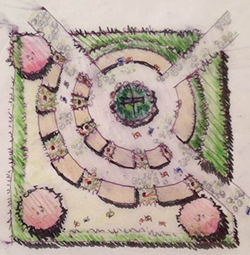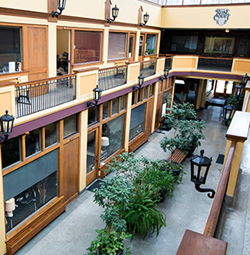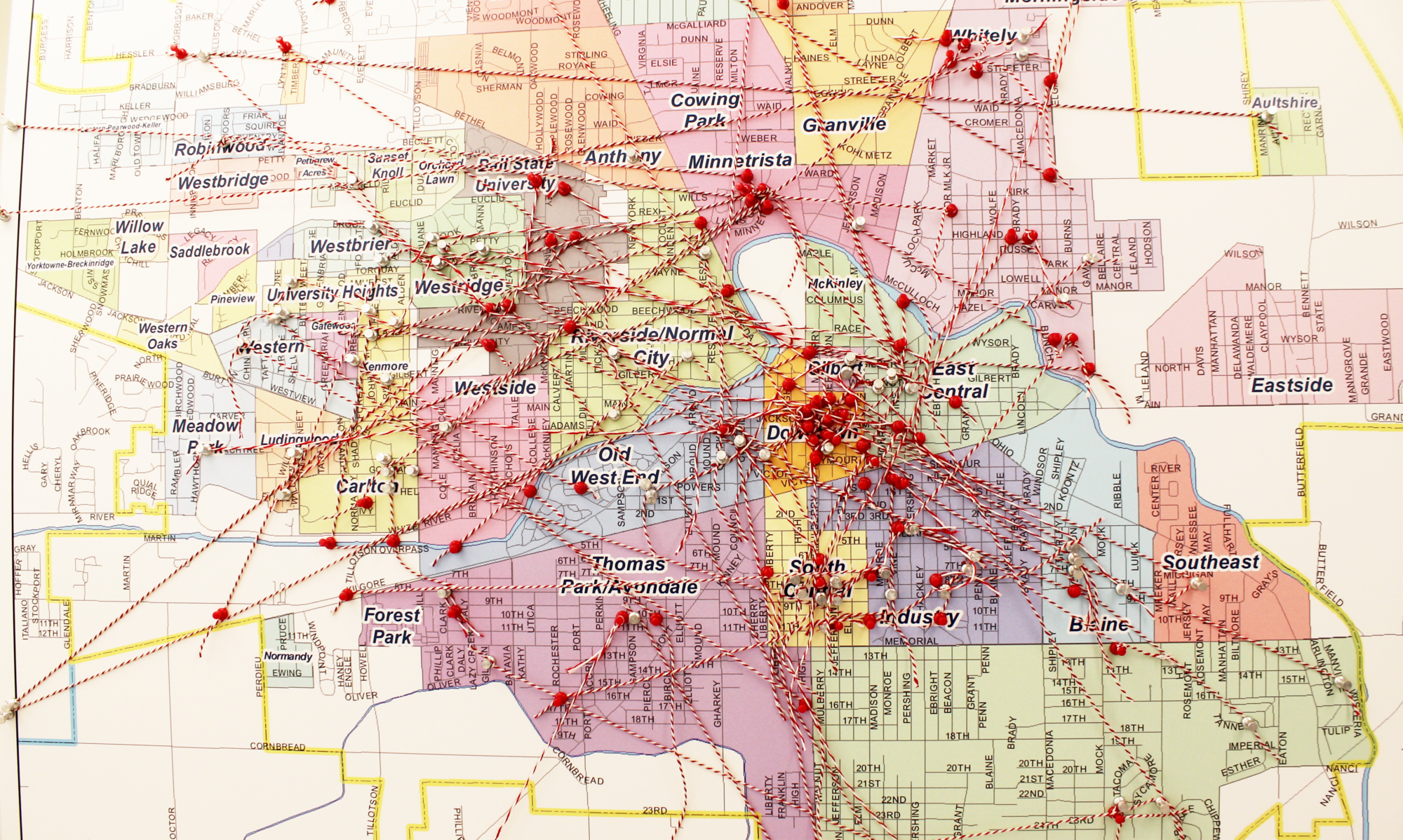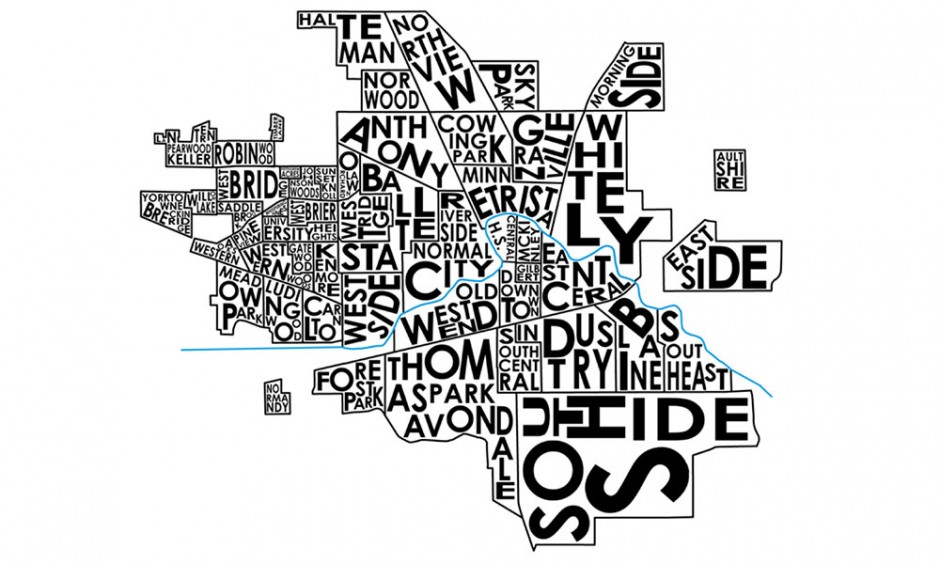Building Better Neighborhoods connects Ball State resources to local initiatives
Building Community Connections Newsletter – May 2015
 A new oasis is coming to the corner of West Main Street and North Cherry Street near downtown Muncie. The former site of a blighted house demolished in 2011, the planned pocket park will have pergolas, ornamental trees, native plants, an herb garden, and a seven-foot-tall sculpture designed and built by resident artist, Brenda Whitaker. The project is funded by a Ball Brothers Foundation Rapid Grant and donations of materials and labor.
A new oasis is coming to the corner of West Main Street and North Cherry Street near downtown Muncie. The former site of a blighted house demolished in 2011, the planned pocket park will have pergolas, ornamental trees, native plants, an herb garden, and a seven-foot-tall sculpture designed and built by resident artist, Brenda Whitaker. The project is funded by a Ball Brothers Foundation Rapid Grant and donations of materials and labor.
Many hours already have been donated by Ball State assistant professor of anthropology Nick Kawa and a student team of landscape architecture, urban planning, and anthropology majors who designed the park after talking with Old West End Neighborhood residents at their monthly association meetings. According to Kawa, the students have been involved largely on a volunteer basis and have strived to reflect the desires of the residents and the unique characteristics of the neighborhood. He believes that the pocket park, coupled with the HUB Community Garden at Main and High Streets, will be the start of a larger movement for “greening” downtown Muncie.
This project is just one recent example of Ball State faculty, students, community partners, and residents working together to transform Muncie neighborhoods. Heather Williams sees these types of successful collaborations all the time. As Ball State’s director of the Building Better Neighborhoods (BBN) Initiative, Williams is tasked with connecting university expertise and resources with the development efforts of Muncie’s 48 neighborhoods. In her words, “what I try to do is fill gaps and needs, finding ways to get Ball State students involved.”
 The Building Better Neighborhoods initiative was launched in 2014 through a three-year, $200,000 grant from the Ball Brothers Foundation. Research shows that neighborhood associations can be instrumental in promoting self-efficacy, collective efficacy, and a sense of community among residents[1]. In support of the Muncie Action Plan and Delaware County’s VISION 2016 economic development plan, BBN’s goals include raising up fully-functioning neighborhood associations across the city, deploying Ball State resources to support these associations, engaging Muncie’s nonprofit sector in neighborhood development, and developing an evaluation system to measure the impact of neighborhood-related projects. BBN is headquartered in the Rose Court building in downtown Muncie.
The Building Better Neighborhoods initiative was launched in 2014 through a three-year, $200,000 grant from the Ball Brothers Foundation. Research shows that neighborhood associations can be instrumental in promoting self-efficacy, collective efficacy, and a sense of community among residents[1]. In support of the Muncie Action Plan and Delaware County’s VISION 2016 economic development plan, BBN’s goals include raising up fully-functioning neighborhood associations across the city, deploying Ball State resources to support these associations, engaging Muncie’s nonprofit sector in neighborhood development, and developing an evaluation system to measure the impact of neighborhood-related projects. BBN is headquartered in the Rose Court building in downtown Muncie.
Williams is a Ball State alum, with bachelor degrees in history and Spanish, a master’s degree in business administration with a specialization in entrepreneurship, and a master’s degree in urban planning with focus on community development, economic development, and international planning. She has served the city of Muncie as a zoning officer and structural inspector for the Building Commissioner’s Office, planner and NSP3 coordinator for the Community Development Department, and assistant administrator of the Unsafe Building Hearing Authority. Her graduate thesis, A History of Neglect: The Use of Federal Recovery Funds to Combat Vacancy and Blight in Muncie, IN, was recently published by Lambert Academic Publishing and is available via Amazon.
The 27 neighborhood associations established to date represent more than half of Muncie’s neighborhoods, but Williams is aiming for 100% participation by the end of 2015.
“Every neighborhood has its own culture, its own approach to tackling problems. Therefore every neighborhood association looks different, too,” she said. “But the positive outcomes are the same – a unified voice, greater connection with neighbors, increased neighborhood pride, improved safety, and empowerment of residents.”
Williams will continue to find creative ways to connect Ball State faculty and students with local improvement projects. Over the last school year, five Building Better Communities Fellows projects have focused on specific Muncie neighborhoods, including surveys and/or action plans for Blaine/Southeast, Industry, Southside, and Riverside/Normal. This summer, urban planning faculty and students will work with the Vectren Foundation in the Thomas Park/Avondale neighborhood to assess energy use and implement energy upgrades. In the same neighborhood, Ball State business students will support Habitat for Humanity’s neighborhood revitalization efforts by surveying and interviewing local businesses to understand their perceived needs.
The Building Better Neighborhoods website (muncieneighborhoods.org), created by Williams and Chris Flook, a telecommunications instructor at Ball State, highlights current projects as well as maps, events, and neighborhood association meetings. Williams hopes that this site will become a key portal for neighborhood-related information in Muncie, but her primary goal is to establish more face-to-face contact through neighborhood meetings. Not only do these meetings reinforce a sense of community, they provide a valuable venue for city officials – such as representatives from Muncie’s Community Development Department, Sanitary District, Streets Department, and the Building Commissioner’s Office – to meet in person with residents and address their concerns.
“It is amazing the difference that simple communication – saying hello, knowing your neighbors’ names – can make to how you feel about where you live,” said Williams. “Community is essential to our personal health and well-being, as well as to the well-being of our city. By connecting with those people who live closest to us, we can set our neighborhoods on paths toward wellness and prosperity.”
[1] Ohmer, M. (2007). Citizen Participation in Neighborhood Organizations and Its Relationship to Volunteers’ Self- and Collective Efficacy and Sense of Community. Social Work Research 31(2): 109-120.

